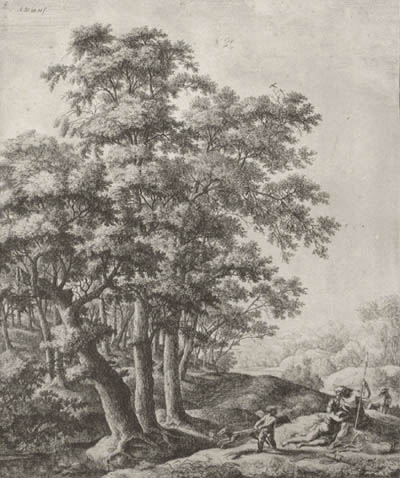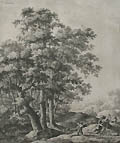| Title: |
Landscape with Venus and Adonis |
| Artist: |
Waterloo, Anthonie (Lille, c. 1610 - Utrecht, c. 1690) |
| Date: |
c. 1655 - 1660 (Second Edition, as Published by Danckerts,
c. 1690) |
| Medium: |
Original Etching |
| Publisher: |
Danckerts |
| Note: |
Anthonie Waterloo 'Antoni Waterloo': For being one of the most famous
masters of Dutch seventeenth century etching, surprisingly little is known
of the actual life of Anthonie Waterloo. His artistic training is not
known and he was probably self-taught. Anthonie Waterloo moved about considerably
during his life. After leaving his native Lille he settled in Utrecht.
In 1640 he was living in Amsterdam as his marriage was registered there.
He then moved to Leeuwarden in Friesland and became a citizen there in
1643. After another period in Amsterdam he returned to live in Leeuwarden
in 1654. Anthonie Waterloo finally settled permanently in Utrecht several years
later. It is also known that he traveled through parts of Germany, the
South Netherlands and possibly Italy. |
| |
In total, Anthonie Waterloo created one hundred and twenty-six
original etchings. None are dated. Until quite recently, scholars ascribed
about twenty further etchings to his hand, but these have since been found
to have been the work of Johannes Ruisscher (c. 1625-1675), whose plates
were published by Waterloo posthumously. Anthonie Waterloo's etchings concentrate
almost solely upon landscape views. In particular, his characteristic
depictions of forests and trees became immensely popular during the eighteenth
century and many artists in Europe attempted to imitate his style. |
| |
Most of Anthonie Waterloo's etched plates were reprinted in editions
in the later seventeenth century by Danckerts, in Amsterdam, and in the
eighteenth century, mainly by the Paris publisher, Basan. These later
edition impressions are often traced due to both the wear on the plates
(particularly with the Basan impressions) and minor additions of lines
and shadings. In Landscape with Venus and Adonis, for example,
the Danckerts impressions contain additional vertical and horizontal shading
to the foliage of the distant trees along the right margins and extensive
cross-hatching in the bushes above the head of the standing dog. This
impression bears both these elements. In the final Basan edition, strong
horizontal shading has been added on the bank above the lying dog's back
as well as vertical shading to create a shadow beneath Adonis's left leg.
As this finely printed impression lacks these additions one must conclude
that it originates from the late 17th century edition published by Danckerts. |
| |
Landscape with Venus and Adonis hails from a set
of six large landscape etchings dealing with the life of Adonis which
most scholars theorize was completed by Anthonie Waterloo sometime within the years
of 1655 to 1660. He may have visited Italy during this period and these
etchings reflect certain Italianate Baroque influences, particularly in
the delineation of the principal figures. In each of these six etchings
(which are among Anthonie Waterloo's largest compositions), however, the drama
is dominated by Anthonie Waterloo's brilliant renderings of the surrounding landscapes.
Landscape with Venus and Adonis contains all the compositional
elements that have made Waterloo's art so sought after. His wonderful
use of light and shade and his magnificent renderings of field and forest
makes it prime example of the Golden Age of Dutch landscape etching. |
| Raisonne: |
Peter Morse, The Illustrated Bartsch: Antoni Waterloo,
New York, Abaris Books, 1992. |
| |
Catalogue #129, Second Edition, Third State of Four a Published
by Danckerts. |
| |
Morse notes that the first state consists of only one known
trial proof in the collection of the British Museum which lacks the 'A.
W. in. et f.' in the upper left as well as the number '5'. The second
through the fourth states contain these letters and the number. |
| Size: |
11 1/4 X 9 1/2 (Sizes in inches are approximate,
height preceding width of plate-mark or image.) |
| |
Framed and Matted with 100% Archival Materials |
| |
View larger Framed Image |
| |
 |
| Condition: |
Printed upon late seventeenth century hand-made, laid paper
and with thread margins as usual. Signed in the plate to the upper left
with the artist's usual "A.W." monogramme. Containing very faint foxing
in the upper margins, else a finely printed impression of the third state
of four and in very good condition throughout. Landscape with Venus
and Adonis represents a prime, original example of the famous 17th
century landscape art of Anthonie Waterloo. |
| |
An as yet unidentified early collector's mark appears on
the verso of this etching. It has been photographed and enlarged to accompany
the documentation. |
| Price: |
Sold - The price is no longer available. |
| Important Information: |
The artist biographies, research and or information pertaining to all the original works of art posted on our pages has been written and designed by Greg & Connie Peters exclusively for our site, (www.artoftheprint.com). Please visit us regularly to view the latest artworks offered for sale. We will soon be posting an update of our most recent research and include the biographical and historical information pertaining to our next collection of original works of art created by artists throughout the centuries. We hope you found the information you were looking for and that it has been beneficial.
Our Gallery, (Art of the Print / www.artoftheprint.com) guarantees the authenticity of every work of art we sell 100%. Full documentation and certification is provided. We offer a wide selection of international fine art dating from the early Renaissance to the contemporary art period. |







![]()
![]() or
phone Greg & Connie (905) 957-6666
or
phone Greg & Connie (905) 957-6666